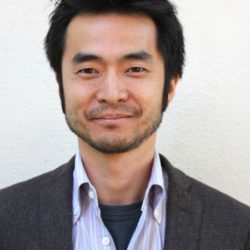
Takeshi Kata
Theatrical Scenic Designer
Cultural Artists Spotlight: February 12 – February 25, 2020
Can you tell us a little bit about what you do?
I am a theatrical set designer. I work with playwrights, directors, lighting, costume, sound and projection designers to create a world for a play. I also work with amazing technical directors, props artisans, and scenic painters who do the heavy lifting to bring our ideas to life.
Depending on the needs/style of the play my job becomes different. Sometimes it is the verisimilitude that is desired to tell the story well, and at other times what’s needed is a simple evocative space. The performance/audience relationship takes many forms. It can feel more voyeuristic, witnessing an intimate, private emotional strife from the outside, or it can be an escapist entertainment that lift our hearts, or at times it can feel like a guided meditation we go through together, using our collective empathetic imagination, lead by poetic language and an elevated performance. My work is to dream up the kind of space that set up the right expectation, the rules of engagement as it were, and help the audience’s imagination take flight.
For me, designing scenery is most exciting when I can give just enough to suggest and leave plenty of space for the imagination to fill in. My process requires text analysis, researching the world of the play, understanding the emotional quality of the piece, performance style and trying to distill it all to its essence. When the space is felt but not noticed, I feel that I have succeeded in doing my work.
How did you first become interested in art?
I’ve always drawn. Ever since I was a little kid growing up in Japan, I enjoyed drawing. I went through phases wanting to be a comic book artist, illustrator and a sculptor, but never really having a story of my own to tell. I was exposed to theater at a young age and always enjoyed seeing plays, dances and many different kind of live performances, but didn’t have an interest in performing on stage. I had an opportunity to work back stage while I was a cultural exchange student in New Jersey at Dwight Englewood High School. Working back stage, building scenery, hanging lights and painting drops made me realize that I can use the skills I’ve acquired sketching and sculpting to help tell a narrative that already exists.
I ended up applying to colleges in the U.S. to study theatrical design. I went to Ithaca College, and spent Summers working at Williamstown Theatre Festival and got my masters degree from Yale School of Drama. I have been a freelance designer since I got out of school in 2001. I spent 6 years in NYC then moved to LA in 2006. We moved to Burbank in 2012 and have been here since. I work in my studio in our house, sketching, drafting and building models.
How can art enrich a community, and what are some ways people can become engaged with art in Burbank?
Specific to theater, I believe it can be a place we gather to collectively practice our empathetic imagination. To feel the collective emotion in the room which makes us realize that we are much more porous than we think we are, and to recognize the amount of empathy we can feel when allowed to, is a powerful and important experience. What can be more enriching for a community than the empathy we can feel and share together?
Burbank has theaters that are easy to access, as well as strong performing arts education at many of the public schools where you can see high quality performances. Go see a play, I think you can be surprised realizing how much you can feel seeing a completely made up story, surrounded by your fellow community members.
If you could share with our community one thing about art, what would it be?
Drawing has always helped me connect to my inner quiet, where my impulses whisper. There are so many ways in which you can engage in art. Expression through a brush, body, music, language, all require us to slow our mind chatter and listen to our inner impulses. I hope you find a medium that helps you find that quiet.
To find out more about Takeshi’s work, visit https://takeshi-kata.squarespace.com
